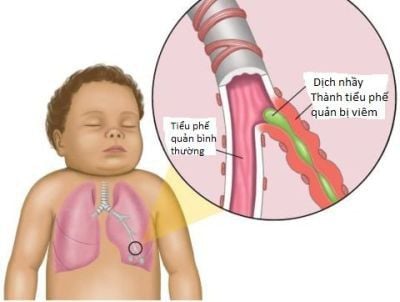This is an automatically translated article.
The article is professionally consulted by Master, Doctor Phan Ngoc Hai - Pediatrician - Neonatologist - Department of Pediatrics - Neonatal - Vinmec Danang International General Hospital.Laryngeal flaccidity is the most common congenital laryngeal abnormality in neonates. It usually goes away on its own without treatment as the child gets older. However, if the condition is advanced, surgery is considered the most effective method to avoid health consequences later on.
1. What is laryngeal flaccid disease?
Laryngeal molluscum contagiosum is a congenital abnormality that causes the epiglottis to narrow during inspiration, leading to intermittent upper airway obstruction and laryngeal stridor.Laryngeal fibrillation is the most common cause of hiss in infants, and is also the most common congenital abnormality in the larynx, accounting for 60% - 70%.
Laryngeal softening occurs when the epiglottis narrows during inspiration. The exact cause is currently unknown, but many mechanisms may work together. The following are the factors that lead to laryngeal fibrillation.
Due to anatomical abnormalities: Possibly due to the short funnel fold - the short epiglottis and the omega-shaped epiglottis contribute to the narrowing of the epiglottis. Nerve pathways are not fully mature, so nerve-muscle coordination is incomplete, causing airway tone in this region to be lower than it should be. Some studies have suggested that in gastroesophageal reflux disease, the inflammation and edema of the mucosa will cause narrowing of the epiglottis, increasing the risk of obstruction and leading to laryngospasm. manage . See more: Learn about laryngeal soft tissue

2. Classification of laryngeal flaccid disease
We can classify laryngopharyngeal molluscum contagiosum clinically as follows:2.1 Mild level A hissing sound can be heard and endoscopic findings can detect laryngospasm, but the patient has no respiratory failure. with and without evidence of growth retardation.
2.2 Moderate There is stridor, increased accessory respiratory muscle contractions, difficulty feeding (eating), and the patient has weight loss or inadequate weight gain.
2.3 Severity Severe dyspnea and airway obstruction, failure to thrive, dysphagia, hypoxemia or hypercoaemia, pulmonary hypertension, sleep apnea, thoracic deformity severe (sternal depression), and slow development of the nervous system - motor.
See more: What to do when the child has soft laryngeal cartilage?
3. Soft surgery of laryngeal cartilage

Softening laryngeal cartilage surgery is difficult to avoid possible complications. Therefore, it is necessary to perform surgery at medical centers with full modern equipment and a team of skilled and experienced medical staff to minimize possible complications.
Laryngoplasty is indicated for moderate and severe progression of the disease
Moderate:
Surgery is indicated when the patient has severe airway obstruction and respiratory failure, or when the patient cannot suck (eat) enough for normal growth. The most commonly used surgery is the laryngopharyngeal cartilage reconstruction method to realign the epiglottis and release the obstruction. Open the trachea when necessary. However, the risks of complications and sequelae of tracheostomy should be taken into account (the mortality rate associated with tracheostomy is 2%). Support: treatment of reflux. Severity:
Surgery is performed when laryngeal fibrillation is severe in 10%-15% of cases. Shaping the glottis-fungus splint to release obstruction in the epiglottis is a commonly used measure. Tracheostomy, support: Treatment of reflux. Surgical treatment of laryngeal fibrillation will be safe if performed correctly by a qualified doctor with all the necessary medical equipment. Therefore, it is necessary to undergo medical examination and treatment at reputable medical facilities to limit possible risks.
Please dial HOTLINE for more information or register for an appointment HERE. Download MyVinmec app to make appointments faster and to manage your bookings easily.














